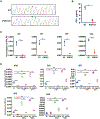Photosensitivity and type I IFN responses in cutaneous lupus are driven by epidermal-derived interferon kappa
- PMID: 30021804
- PMCID: PMC6185784
- DOI: 10.1136/annrheumdis-2018-213197
Photosensitivity and type I IFN responses in cutaneous lupus are driven by epidermal-derived interferon kappa
Abstract
Objective: Skin inflammation and photosensitivity are common in patients with cutaneous lupus erythematosus (CLE) and systemic lupus erythematosus (SLE), yet little is known about the mechanisms that regulate these traits. Here we investigate the role of interferon kappa (IFN-κ) in regulation of type I interferon (IFN) and photosensitive responses and examine its dysregulation in lupus skin.
Methods: mRNA expression of type I IFN genes was analysed from microarray data of CLE lesions and healthy control skin. Similar expression in cultured primary keratinocytes, fibroblasts and endothelial cells was analysed via RNA-seq. IFNK knock-out (KO) keratinocytes were generated using CRISPR/Cas9. Keratinocytes stably overexpressing IFN-κ were created via G418 selection of transfected cells. IFN responses were assessed via phosphorylation of STAT1 and STAT2 and qRT-PCR for IFN-regulated genes. Ultraviolet B-mediated apoptosis was analysed via TUNEL staining. In vivo protein expression was assessed via immunofluorescent staining of normal and CLE lesional skin.
Results: IFNK is one of two type I IFNs significantly increased (1.5-fold change, false discovery rate (FDR) q<0.001) in lesional CLE skin. Gene ontology (GO) analysis showed that type I IFN responses were enriched (FDR=6.8×10-04) in keratinocytes not in fibroblast and endothelial cells, and this epithelial-derived IFN-κ is responsible for maintaining baseline type I IFN responses in healthy skin. Increased levels of IFN-κ, such as seen in SLE, amplify and accelerate responsiveness of epithelia to IFN-α and increase keratinocyte sensitivity to UV irradiation. Notably, KO of IFN-κ or inhibition of IFN signalling with baricitinib abrogates UVB-induced apoptosis.
Conclusion: Collectively, our data identify IFN-κ as a critical IFN in CLE pathology via promotion of enhanced IFN responses and photosensitivity. IFN-κ is a potential novel target for UVB prophylaxis and CLE-directed therapy.
Keywords: autoimmune diseases; cytokines; inflammation.
© Author(s) (or their employer(s)) 2018. No commercial re-use. See rights and permissions. Published by BMJ.
Conflict of interest statement
Competing interests: None declared.
Figures






References
-
- Sanders CJ, Van Weelden H, Kazzaz GA, et al. Photosensitivity in patients with lupus erythematosus: a clinical and photobiological study of 100 patients using a prolonged phototest protocol. Br J Dermatol 2003;149(1):131–7. doi: 10.1046/j.1365-2133.2003.05379.x [pii] [published Online First: 2003/08/02] - DOI - PubMed
-
- Braunstein I, Klein R, Okawa J, et al. The interferon-regulated gene signature is elevated in subacute cutaneous lupus erythematosus and discoid lupus erythematosus and correlates with the cutaneous lupus area and severity index score. British Journal of Dermatology 2012;166(5):971–75. doi: 10.1111/j.1365-2133.2012.10825.x - DOI - PMC - PubMed
Publication types
MeSH terms
Substances
Grants and funding
LinkOut - more resources
Full Text Sources
Other Literature Sources
Molecular Biology Databases
Research Materials
Miscellaneous

